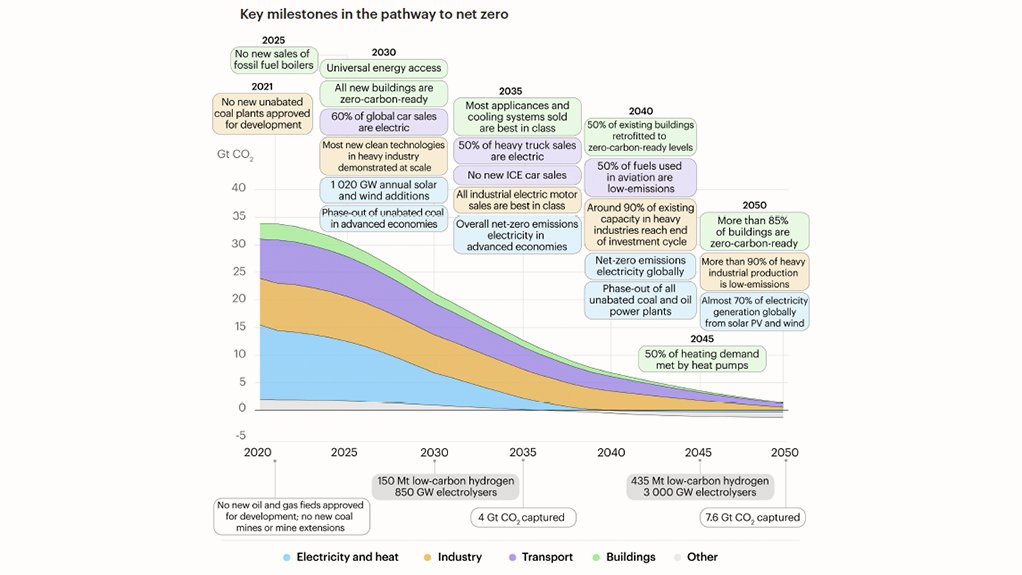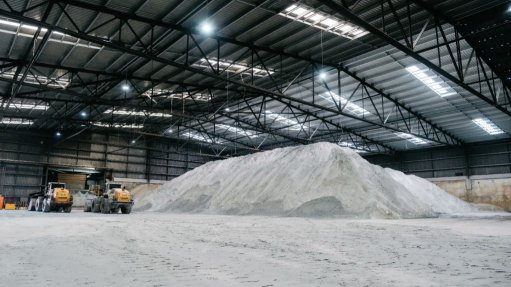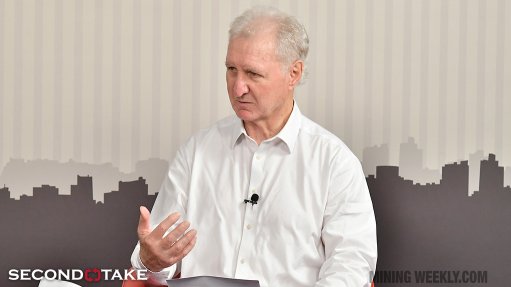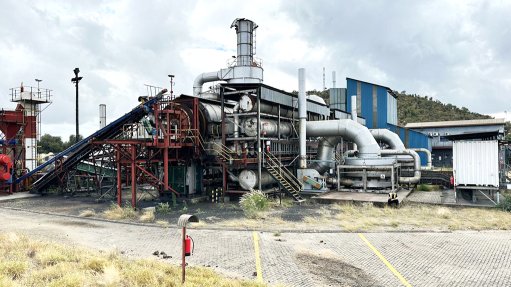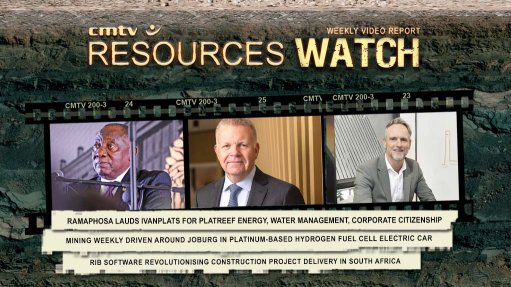No place for new coal in $5tr/y transition to net-zero by 2050 – IEA study
A new and far-reaching study of how to transition the global energy system to one with net-zero carbon emissions by 2050 highlights the need for a dramatic acceleration in the pace and scale of renewable-energy and grid investment, while simultaneously halting new fossil-fuel supply projects and abandoning any new unabated coal plants.
Published by the International Energy Agency (IEA) as part of preparations for the twenty-sixth Conference of the Parties, or COP26, climate gathering scheduled for Glasgow, Scotland, in November, the ‘Net Zero by 2050: A Roadmap for the Global Energy Sector’ report concludes that the world has a viable, albeit narrow, pathway for limiting the global temperature rise to 1.5 °C above preindustrial levels.
Central to the pathway is a rise in the role of electricity, derived primarily from increasingly cost-competitive renewable plants, in achieving net-zero.
Electricity, the IEA shows, will need to account for almost 50% of total energy consumption in 2050 and play a key role across all sectors, from transport to buildings and industry, including becoming a key input for producing low-emissions fuels such as hydrogen.
To achieve this, total electricity generation increases over two-and-a-half times between today and 2050 and no additional new final investment decisions are taken for new unabated coal plants, while the least efficient coal plants are phased out by 2030, and the remaining coal plants still in use by 2040 are retrofitted to capture carbon.
“By 2050, almost 90% of electricity generation comes from renewable sources, with wind and solar photovoltaic (PV) together accounting for nearly 70%. Most of the remainder comes from nuclear,” the report states.
Described as the world’s first comprehensive study of how to transition to a net-zero energy system by 2050, while also ensuring stable, affordable and universal energy access, the report calls on policymakers to prioritise the following:
- Raising total yearly energy investment to $5-trillion by 2030, which would add an extra 0.4 percentage point a year to annual global gross domestic production (GDP) growth, and place global GDP 4% higher in 2030 than it would be based on current trends.
- A rapid scaling up of solar PV and wind this decade to reach a yearly additions tempo of 630 GW of solar PV and 390 GW of wind by 2030, four times the record levels set in 2020.
- Enabling infrastructure and technologies key to transforming the energy system, such as transmission and distribution grid expansions and electric vehicle (EV) charging points. Yearly investment in transmission and distribution grids will need to expand under the pathway from $260-billion today to $820-billion in 2030, while the number of public charging points for EVs rises from around 1-million today to 40-million in 2030, requiring yearly investment of almost $90-billion in 2030.
- A massive roll-out of efficient energy technologies to support a world economy in 2030 that is some 40% larger than today but which uses 7% less energy.
- The implementation of policies to limit, or provide disincentives for, the use of certain fuels and technologies, such as unabated coal-fired power stations, gas boilers and conventional internal combustion engine (ICE) vehicles. The report states that, beyond projects already committed as of 2021, no further new oil and gas fields should be approved, while new coal mines or mine extensions are not required. One of the 400 milestones in the report is a halt to all ICE vehicle sales by 2035.
- An intensification of research and development, as well as demonstration projects to unlock and commercialise advanced batteries, hydrogen electrolysers and direct air capture and storage, which are seem as the highest-potential new technologies to support the net-zero transition. About $90-billion of public money needs to be mobilised globally to complete a portfolio of demonstration projects before 2030, with only $25-billion currently budgeted. The report shows that most of the global reductions in carbon emissions between now and 2030 can come from technologies readily available today but that, in 2050, almost half the reductions come from technologies that are currently only at the demonstration or prototype phase.
- Facilitating substantial investment in critical minerals, with the total market size for minerals such as copper, cobalt, manganese and various rare earth metals to grow by almost sevenfold between 2020 and 2030 in the net zero pathway. Revenues from those minerals are larger than revenues from coal well before 2030, creating substantial new opportunities for mining companies, but also raising energy security concerns.
- Placing people at the centre of the energy transition to ensure public support in light of an IEA estimate that about 55% of the cumulative emissions reductions in the net-zero pathway are linked to consumer choices such as purchasing an EV, retrofitting a house with energy-efficient technologies or installing a heat pump. At the same time, the pathway envisages the provision of electricity to the some 785-million people that currently have no access, as well as clean cooking solutions to 2.6-billion people that still lack those options.
- Ensuring that clean energy jobs, which will grow rapidly, are evenly spread. The report estimates that the transition to net-zero could create 14-million jobs and 16-million construction jobs by 2030, but that five-million fossil-fuel jobs will be lost.
- And intensify international cooperation to tackle the global challenge through coordinated action rather than simply through individual governments seeking to bring their national emissions to net zero.
The IEA said that new energy security challenges will emerge on the way to net zero by 2050, even as the role of oil and gas diminishes.
“The contraction of oil and natural gas production will have far-reaching implications for all the countries and companies that produce these fuels . . . [while] OPEC’s share of a much-reduced global oil supply grows from around 37% in recent years to 52% in 2050, a level higher than at any point in the history of oil markets.”
In addition, there could be energy security challenges arising as a result of the increasing importance of electricity. These could include the variability of supply from some renewables, cybersecurity risks and a rising dependence on critical minerals, with associated risks of price volatility and supply disruptions.
IEA executive director Fatih Birol sad that report showed that the prospects for achieving net-zero emissions by 2050, while challenging, was not yet lost and also held potential economic and social benefits.
“The IEA’s pathway to this brighter future brings a historic surge in clean energy investment that creates millions of new jobs and lifts global economic growth. Moving the world onto that pathway requires strong and credible policy actions from governments, underpinned by much greater international cooperation.”
Nevertheless, he stressed that each country would need to design its own strategy, taking into account its own specific circumstances.
“Plans need to reflect countries’ differing stages of economic development: in our pathway, advanced economies reach net0-zero before developing economies,” Birol concluded.
Article Enquiry
Email Article
Save Article
Feedback
To advertise email advertising@creamermedia.co.za or click here
Press Office
Announcements
What's On
Subscribe to improve your user experience...
Option 1 (equivalent of R125 a month):
Receive a weekly copy of Creamer Media's Engineering News & Mining Weekly magazine
(print copy for those in South Africa and e-magazine for those outside of South Africa)
Receive daily email newsletters
Access to full search results
Access archive of magazine back copies
Access to Projects in Progress
Access to ONE Research Report of your choice in PDF format
Option 2 (equivalent of R375 a month):
All benefits from Option 1
PLUS
Access to Creamer Media's Research Channel Africa for ALL Research Reports, in PDF format, on various industrial and mining sectors
including Electricity; Water; Energy Transition; Hydrogen; Roads, Rail and Ports; Coal; Gold; Platinum; Battery Metals; etc.
Already a subscriber?
Forgotten your password?
Receive weekly copy of Creamer Media's Engineering News & Mining Weekly magazine (print copy for those in South Africa and e-magazine for those outside of South Africa)
➕
Recieve daily email newsletters
➕
Access to full search results
➕
Access archive of magazine back copies
➕
Access to Projects in Progress
➕
Access to ONE Research Report of your choice in PDF format
RESEARCH CHANNEL AFRICA
R4500 (equivalent of R375 a month)
SUBSCRIBEAll benefits from Option 1
➕
Access to Creamer Media's Research Channel Africa for ALL Research Reports on various industrial and mining sectors, in PDF format, including on:
Electricity
➕
Water
➕
Energy Transition
➕
Hydrogen
➕
Roads, Rail and Ports
➕
Coal
➕
Gold
➕
Platinum
➕
Battery Metals
➕
etc.
Receive all benefits from Option 1 or Option 2 delivered to numerous people at your company
➕
Multiple User names and Passwords for simultaneous log-ins
➕
Intranet integration access to all in your organisation



